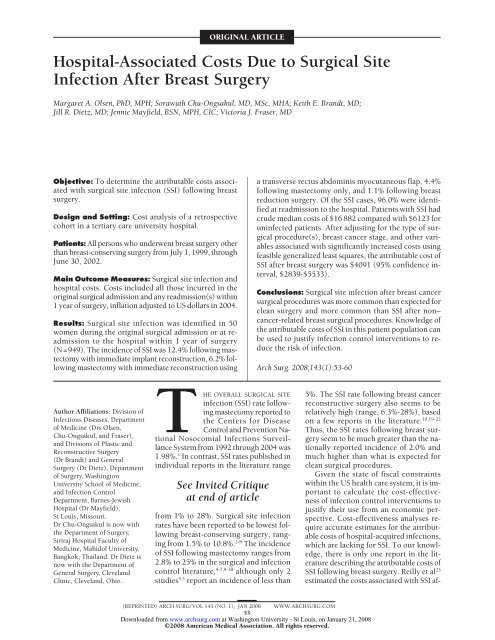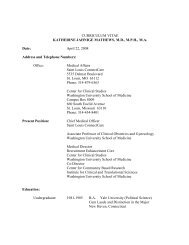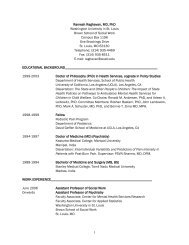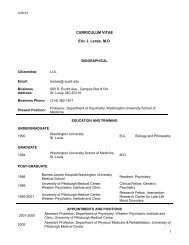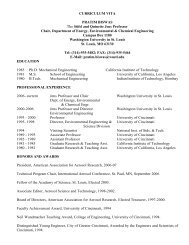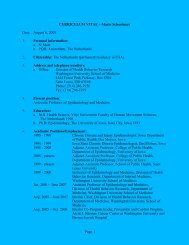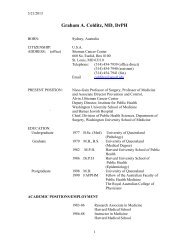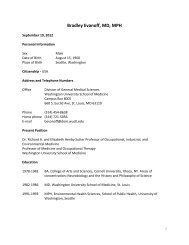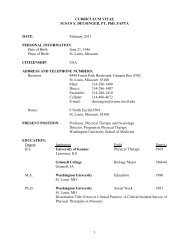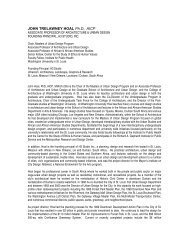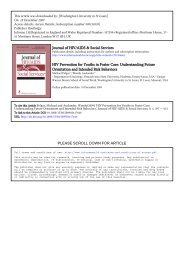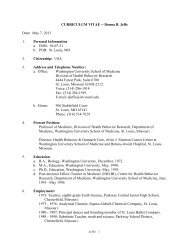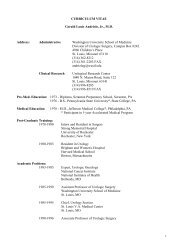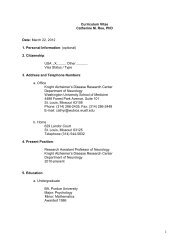Hospital-Associated Costs Due to Surgical Site Infection After Breast ...
Hospital-Associated Costs Due to Surgical Site Infection After Breast ...
Hospital-Associated Costs Due to Surgical Site Infection After Breast ...
You also want an ePaper? Increase the reach of your titles
YUMPU automatically turns print PDFs into web optimized ePapers that Google loves.
ORIGINAL ARTICLE<br />
<strong>Hospital</strong>-<strong>Associated</strong> <strong>Costs</strong> <strong>Due</strong> <strong>to</strong> <strong>Surgical</strong> <strong>Site</strong><br />
<strong>Infection</strong> <strong>After</strong> <strong>Breast</strong> Surgery<br />
Margaret A. Olsen, PhD, MPH; Sorawuth Chu-Ongsakul, MD, MSc, MHA; Keith E. Brandt, MD;<br />
Jill R. Dietz, MD; Jennie Mayfield, BSN, MPH, CIC; Vic<strong>to</strong>ria J. Fraser, MD<br />
Objective: To determine the attributable costs associated<br />
with surgical site infection (SSI) following breast<br />
surgery.<br />
Design and Setting: Cost analysis of a retrospective<br />
cohort in a tertiary care university hospital.<br />
Patients: All persons who underwent breast surgery other<br />
than breast-conserving surgery from July 1, 1999, through<br />
June 30, 2002.<br />
Main Outcome Measures: <strong>Surgical</strong> site infection and<br />
hospital costs. <strong>Costs</strong> included all those incurred in the<br />
original surgical admission and any readmission(s) within<br />
1 year of surgery, inflation adjusted <strong>to</strong> US dollars in 2004.<br />
Results: <strong>Surgical</strong> site infection was identified in 50<br />
women during the original surgical admission or at readmission<br />
<strong>to</strong> the hospital within 1 year of surgery<br />
(N=949). The incidence of SSI was 12.4% following mastec<strong>to</strong>my<br />
with immediate implant reconstruction, 6.2% following<br />
mastec<strong>to</strong>my with immediate reconstruction using<br />
a transverse rectus abdominis myocutaneous flap, 4.4%<br />
following mastec<strong>to</strong>my only, and 1.1% following breast<br />
reduction surgery. Of the SSI cases, 96.0% were identified<br />
at readmission <strong>to</strong> the hospital. Patients with SSI had<br />
crude median costs of $16 882 compared with $6123 for<br />
uninfected patients. <strong>After</strong> adjusting for the type of surgical<br />
procedure(s), breast cancer stage, and other variables<br />
associated with significantly increased costs using<br />
feasible generalized least squares, the attributable cost of<br />
SSI after breast surgery was $4091 (95% confidence interval,<br />
$2839-$5533).<br />
Conclusions: <strong>Surgical</strong> site infection after breast cancer<br />
surgical procedures was more common than expected for<br />
clean surgery and more common than SSI after non–<br />
cancer-related breast surgical procedures. Knowledge of<br />
the attributable costs of SSI in this patient population can<br />
be used <strong>to</strong> justify infection control interventions <strong>to</strong> reduce<br />
the risk of infection.<br />
Arch Surg. 2008;143(1):53-60<br />
Author Affiliations: Division of<br />
Infectious Diseases, Department<br />
of Medicine (Drs Olsen,<br />
Chu-Ongsakul, and Fraser),<br />
and Divisions of Plastic and<br />
Reconstructive Surgery<br />
(Dr Brandt) and General<br />
Surgery (Dr Dietz), Department<br />
of Surgery, Washing<strong>to</strong>n<br />
University School of Medicine,<br />
and <strong>Infection</strong> Control<br />
Department, Barnes-Jewish<br />
<strong>Hospital</strong> (Dr Mayfield),<br />
St Louis, Missouri.<br />
Dr Chu-Ongsakul is now with<br />
the Department of Surgery,<br />
Siriraj <strong>Hospital</strong> Faculty of<br />
Medicine, Mahidol University,<br />
Bangkok, Thailand. Dr Dietz is<br />
now with the Department of<br />
General Surgery, Cleveland<br />
Clinic, Cleveland, Ohio.<br />
THE OVERALL SURGICAL SITE<br />
infection (SSI) rate following<br />
mastec<strong>to</strong>my reported <strong>to</strong><br />
the Centers for Disease<br />
Control and Prevention National<br />
Nosocomial <strong>Infection</strong>s Surveillance<br />
System from 1992 through 2004 was<br />
1.98%. 1 In contrast, SSI rates published in<br />
individual reports in the literature range<br />
See Invited Critique<br />
at end of article<br />
from 1% <strong>to</strong> 28%. <strong>Surgical</strong> site infection<br />
rates have been reported <strong>to</strong> be lowest following<br />
breast-conserving surgery, ranging<br />
from 1.5% <strong>to</strong> 10.8%. 2-8 The incidence<br />
of SSI following mastec<strong>to</strong>my ranges from<br />
2.8% <strong>to</strong> 25% in the surgical and infection<br />
control literature, 4-7,9-18 although only 2<br />
studies 4,5 report an incidence of less than<br />
5%. The SSI rate following breast cancer<br />
reconstructive surgery also seems <strong>to</strong> be<br />
relatively high (range, 6.3%-28%), based<br />
on a few reports in the literature. 10,19-22<br />
Thus, the SSI rates following breast surgery<br />
seem <strong>to</strong> be much greater than the nationally<br />
reported incidence of 2.0% and<br />
much higher than what is expected for<br />
clean surgical procedures.<br />
Given the state of fiscal constraints<br />
within the US health care system, it is important<br />
<strong>to</strong> calculate the cost-effectiveness<br />
of infection control interventions <strong>to</strong><br />
justify their use from an economic perspective.<br />
Cost-effectiveness analyses require<br />
accurate estimates for the attributable<br />
costs of hospital-acquired infections,<br />
which are lacking for SSI. To our knowledge,<br />
there is only one report in the literature<br />
describing the attributable costs of<br />
SSI following breast surgery. Reilly et al 23<br />
estimated the costs associated with SSI af-<br />
(REPRINTED) ARCH SURG/ VOL 143 (NO. 1), JAN 2008 WWW.ARCHSURG.COM<br />
53<br />
Downloaded from www.archsurg.com at Washing<strong>to</strong>n University - St Louis, on January 21, 2008<br />
©2008 American Medical Association. All rights reserved.
ter a variety of different surgical procedures, including<br />
breast surgery. The costs included in this study were those<br />
associated with additional hospital length of stay, outpatient<br />
and home health visits, and outpatient antibiotics.<br />
Using the <strong>to</strong>tal costs attributable <strong>to</strong> infection presented<br />
in their publication, the mean attributable costs<br />
of SSI following breast surgery equaled £359 (approximately<br />
$574 in the United States). 23 It is not clear what<br />
types of breast surgery were included in the analysis (mastec<strong>to</strong>my,<br />
breast-conserving surgery, or cosmetic surgical<br />
procedures) or what proportion of the observed SSI<br />
were diagnosed and treated solely in the outpatient setting.<br />
<strong>Infection</strong>s managed exclusively in an outpatient setting<br />
will presumably be associated with lower costs than<br />
infections requiring rehospitalization. In addition, British<br />
health care delivery and use are different from those<br />
in the United States, so the costs attributable <strong>to</strong> SSI after<br />
breast surgery determined in this study may not be comparable<br />
<strong>to</strong> the costs of SSI in the United States.<br />
Despite the publication of a number of studies describing<br />
costs associated with SSI, the magnitude of economic<br />
costs attributable <strong>to</strong> these infections is still unclear.<br />
<strong>Costs</strong> associated with SSI will likely vary depending<br />
on the type of surgical procedure. <strong>Surgical</strong> site infections<br />
following cardiothoracic or neurosurgical procedures,<br />
with the potential for severe morbidity and mortality,<br />
would presumably have the largest attributable<br />
costs, while infection following surgery not involving major<br />
organ spaces would be expected <strong>to</strong> have lower costs.<br />
This is consistent with the few adjusted estimates of SSI<br />
costs that have been reported. 23-30 We studied the hospitalassociated<br />
costs of SSI following mastec<strong>to</strong>my and breast<br />
reconstructive surgery <strong>to</strong> determine more precisely the<br />
attributable costs of SSI following these procedures.<br />
METHODS<br />
STUDY POPULATION<br />
Procedures eligible for inclusion in this study included all mastec<strong>to</strong>my<br />
and breast reconstructive surgical procedures performed<br />
at Barnes-Jewish <strong>Hospital</strong> (BJH) from July 1, 1999, through<br />
June 30, 2002. Barnes-Jewish <strong>Hospital</strong> is a 1251-bed tertiary care<br />
hospital affiliated with Washing<strong>to</strong>n University School of Medicine.<br />
International Classification of Diseases, Ninth Revision (ICD-9)<br />
procedure codes were used <strong>to</strong> identify eligible surgical admissions<br />
and outpatient surgical procedures, including breast reduction,<br />
augmentation, mastec<strong>to</strong>my, breast reconstruction with transverse<br />
rectus abdominis myocutaneous (TRAM) or other muscle<br />
flap, and insertion of a breast implant (ICD-9 procedure codes<br />
85.31-85.48, 85.7, 85.85, and 85.95). Admissions for breastconserving<br />
surgery (excisional biopsy, lumpec<strong>to</strong>my, or partial mastec<strong>to</strong>my)<br />
and mas<strong>to</strong>pexy only were also excluded, because inpatient<br />
readmission for therapy of SSI after these procedures is rare.<br />
Using these criteria, 949 admissions with breast surgery were included<br />
in the original cohort. Approval for this study was obtained<br />
from the Washing<strong>to</strong>n University School of Medicine Human<br />
Studies Committee.<br />
IDENTIFICATION OF SSI CASE PATIENTS<br />
<strong>Surgical</strong> site infections following breast surgery were identified<br />
by electronic surveillance using data from the BJH Medical<br />
Informatics database. Indica<strong>to</strong>rs suggestive of SSI included<br />
ICD-9 diagnosis codes consistent with wound infection (codes<br />
682.2, 682.3, 998.5, 998.51, 998.59, and 996.69) or breast surgery<br />
complication (codes 611.0, 996.79, 998.3, and 998.83)<br />
and/or positive microbiology wound culture results during the<br />
original surgical admission or any readmission (inpatient or outpatient<br />
surgical) within 1 year of surgery. All potential wound<br />
infections identified by electronic surveillance were verified by<br />
review of the medical records. Centers for Disease Control and<br />
Prevention–National Nosocomial <strong>Infection</strong>s Surveillance System<br />
criteria were used <strong>to</strong> define SSI. <strong>Surgical</strong> site infection required<br />
at least one of the following: purulent drainage from the<br />
incision, organisms isolated from an aseptically obtained culture,<br />
peri-incisional erythema or warmth and the incision was<br />
opened by a physician, abscess found on radiologic or his<strong>to</strong>pathologic<br />
examination, or a diagnosis of SSI by the surgeon.<br />
Only infections diagnosed during the original surgical admission<br />
or at readmission <strong>to</strong> the hospital or <strong>to</strong> outpatient surgery<br />
were included; infections diagnosed and managed solely in the<br />
outpatient setting were excluded, because by definition outpatient<br />
infections would not have associated hospital costs.<br />
VARIABLE CREATION AND DEFINITIONS<br />
Data regarding variables potentially associated with increased<br />
costs were abstracted for the cohort from the BJH Medical Informatics<br />
database. The data available for the entire cohort included<br />
ICD-9 discharge diagnosis and procedure codes, pharmacy<br />
and microbiology data, and demographic information.<br />
Preexisting comorbidities, carcinoma in situ, malignancy, and<br />
his<strong>to</strong>ry of malignancy were defined using the ICD-9 diagnosis<br />
codes assigned during the original surgical admission and the<br />
coding criteria of Deyo et al. 31 Comorbidities selected for analysis<br />
included those generally associated with increased risk of<br />
SSI (eg, diabetes mellitus) and comorbidities that may be more<br />
frequent in the population of patients with SSI and would most<br />
likely be associated with increased costs (eg, serious heart disease).<br />
In addition, frequencies were determined for all ICD-9<br />
diagnosis codes assigned <strong>to</strong> the surgical cohort; all comorbidities<br />
present in more than 1% of the cohort were included in<br />
the statistical analyses. The comorbidities analyzed included<br />
diabetes mellitus, serious heart disease (myocardial infarction<br />
or congestive heart failure), renal failure, chronic obstructive<br />
pulmonary disease, and hypertension. Diagnosis of metastatic<br />
disease was defined using ICD-9 diagnosis codes assigned during<br />
the original surgical admission and any readmission <strong>to</strong> the<br />
hospital within 1 year of surgery. Central venous catheterization<br />
was defined using ICD-9 procedure codes (code 38.93 or<br />
86.07) for the original surgical admission and any hospital readmission<br />
within 1 year of surgery. <strong>Surgical</strong> procedures performed<br />
during the original surgical admission were defined using<br />
ICD-9 procedure codes. All possible logic checks were performed<br />
for variables created from ICD-9 diagnosis and procedure<br />
codes, and discrepant results were verified using the electronic<br />
medical record.<br />
The number of ICD-9 codes assigned during the surgical admission<br />
was used as an indica<strong>to</strong>r of severity of illness rather<br />
than the Charlson comorbidity score (adapted for use with administrative<br />
data), <strong>to</strong> determine the costs associated with specific<br />
comorbidities in this population. The Charlson comorbidity<br />
score is a summary score in which weights are assigned<br />
<strong>to</strong> various comorbidities associated with mortality; because our<br />
intent was <strong>to</strong> develop a precise determination of attributable<br />
costs, we used the individual comorbidities rather than a summary<br />
score in the statistical models <strong>to</strong> calculate costs. 32 In addition,<br />
the Charlson comorbidity score includes diagnosis of<br />
any malignancy in the scoring scheme. Because we wanted <strong>to</strong><br />
(REPRINTED) ARCH SURG/ VOL 143 (NO. 1), JAN 2008 WWW.ARCHSURG.COM<br />
54<br />
Downloaded from www.archsurg.com at Washing<strong>to</strong>n University - St Louis, on January 21, 2008<br />
©2008 American Medical Association. All rights reserved.
specifically control for costs associated with tumor stage in the<br />
patients diagnosed as having in situ or invasive breast cancer<br />
in our statistical models, this was an additional rationale for<br />
not using an aggregated comorbidity score in our models <strong>to</strong> adjust<br />
for severity of illness.<br />
Pharmacy data available from the BJH Medical Informatics<br />
database were also used <strong>to</strong> define some underlying disease variables,<br />
including insulin use in the original surgical admission<br />
or within 1 year of surgery, insulin and oral hypoglycemic agents<br />
as markers of diabetes mellitus, and digoxin use as a marker of<br />
serious heart disease. These variables were compared with the<br />
comorbidity variables previously described, <strong>to</strong> verify the diagnostic<br />
variables and <strong>to</strong> assess the effect of variables created by<br />
combination of the diagnostic and pharmacy information.<br />
COST DATA<br />
Cost data for the cohort from the perspective of the hospital,<br />
including the hospital costs of the original surgical admission<br />
and hospital costs for all readmissions within 1 year of surgery,<br />
were obtained from the BJH cost accounting database<br />
(Trendstar; McKesson Corp, Alpharetta, Georgia). Eligible hospital<br />
readmissions included inpatient, same day, or ambula<strong>to</strong>ry<br />
surgery and outpatient surgery admissions. All readmission<br />
hospital costs within 1 year of surgery were included in<br />
the analyses, <strong>to</strong> hopefully capture all costs involved in the initial<br />
diagnosis and therapy of infection. Because SSI in some patients<br />
may require multiple admissions <strong>to</strong> the hospital for antibiotic<br />
or surgical treatment, we included readmission costs<br />
for all members of the cohort for a 1-year follow-up <strong>to</strong> capture<br />
these costs.<br />
The cost accounting database uses a set-down allocation<br />
method <strong>to</strong> calculate costs, which included indirect variable, direct<br />
variable, and fixed costs. All patient charge codes received<br />
during hospitalizations were recorded, and the departmental<br />
cost for each charge code calculated was based on each<br />
department’s actual cost components multiplied by the charges<br />
for that code, divided by <strong>to</strong>tal departmental charges. <strong>Costs</strong> were<br />
summed across each department <strong>to</strong> provide <strong>to</strong>tal hospital costs<br />
for each admission and were inflation adjusted <strong>to</strong> 2004 US dollars<br />
using the medical care component of the Consumer Price<br />
Index (accessed at http://www.bls.gov). Only hospitalassociated<br />
costs were included in the analysis; physician costs<br />
were not included.<br />
STATISTICAL ANALYSES<br />
The 2 test was used <strong>to</strong> compare categorical variables, and the<br />
Mann-Whitney test was used for continuous variables. Multivariate<br />
analyses <strong>to</strong> determine costs attributable <strong>to</strong> SSI were performed<br />
by ordinary least-squares and feasible generalized leastsquares<br />
(FGLS) regression, using natural log-transformed costs<br />
as the dependent variable, because of the highly skewed distribution<br />
of <strong>to</strong>tal costs. These methods can be used <strong>to</strong> estimate<br />
the costs associated with variables of interest, taking in<strong>to</strong> account<br />
variation in the occurrence of other fac<strong>to</strong>rs significantly<br />
associated with expenditures. The coefficients obtained in the<br />
FGLS model represent the mean change in the variable of interest<br />
per unit increase in X, when the other variables in the<br />
model are held constant. In this study, the change in X represents<br />
the mean difference in the natural logarithm of costs between<br />
individuals with infection and those without infection,<br />
holding all other predic<strong>to</strong>rs of costs constant.<br />
All independent variables were checked for colinearity. The<br />
models were checked for functional form misspecification using<br />
the Ramsey regression specification error test and for heteroscedasticity<br />
using the Breusch-Pagan test. 33 The <strong>to</strong>tal mortality<br />
within 1 year of surgery in the cohort was 1.5% (13/878);<br />
because it was so low, no attempt was made <strong>to</strong> adjust the FGLS<br />
models for mortality.<br />
Data for admissions in which the standardized residuals for<br />
the final model were large (3 SDs from the mean of 0) were<br />
all checked for accuracy. Because the FGLS model used the natural<br />
logarithm of costs as the dependent variable, an intermediate<br />
regression was performed <strong>to</strong> predict costs given that the<br />
dependent variable in the model was ln(costs). 33<br />
Propensity score methods were also used <strong>to</strong> determine the<br />
association between SSI and costs. 34 A nonparsimonious logistic<br />
regression model was used <strong>to</strong> obtain predicted values for<br />
SSI. Patients with SSI were then matched 1:1 with control subjects<br />
based on the propensity score. Total costs were compared<br />
between the matched pairs by the Wilcoxon signed rank<br />
test, and the mean and median differences in <strong>to</strong>tal costs were<br />
calculated. Statistical analyses were performed using commercially<br />
available software programs (SPSS, version 12.0 [SPSS<br />
Inc, Chicago, Illinois] and Stata, version 9.2 [Stata Corp, College<br />
Station, Texas]).<br />
RESULTS<br />
SSI RATES IN THE COHORT<br />
A cohort of 949 admissions in which ICD-9 procedure<br />
codes for mastec<strong>to</strong>my or breast reconstruction were assigned<br />
was established for the 2-year period of the study.<br />
Most surgical procedures (90.6%) resulted in at least an<br />
overnight hospitalization, with only 4 patients who underwent<br />
mastec<strong>to</strong>my (0.7%) discharged on the day of surgery.<br />
A <strong>to</strong>tal of 7.6% (14/185) of reduction-only surgical<br />
procedures, 50.8% (33/65) of delayed implant<br />
placement in patients with cancer, and 62.5% (15/24) of<br />
cosmetic augmentations were performed in outpatient surgery.<br />
<strong>Surgical</strong> site infection was identified in 50 patients<br />
within 1 year of surgery in this cohort (SSI rate, 5.3%).<br />
Thirteen infections (4.4%) followed mastec<strong>to</strong>my only, and<br />
22 were breast implant associated, requiring surgical removal<br />
of the implant in 18. <strong>Surgical</strong> site infection in 45<br />
patients involved the breast incision(s), 7 involved the<br />
abdominal incision in patients who had undergone TRAM<br />
reconstruction, and 1 involved the back incision in a woman<br />
who had undergone latissimus dorsi reconstruction. Three<br />
patients had SSI following TRAM reconstruction involving<br />
the breast and abdominal incisions. <strong>Surgical</strong> site infection<br />
rates were lowest following non–cancer-related<br />
surgical procedures. Rates of SSI according <strong>to</strong> the type of<br />
surgery performed are shown in Table 1.<br />
For the outcome and cost analyses, any readmissions<br />
<strong>to</strong> the hospital within 1 year of surgery, including readmissions<br />
in which eligible breast surgical procedures were<br />
performed, were included in the readmission costs associated<br />
with the original surgical admission. A <strong>to</strong>tal of<br />
61 patients had 1 or more follow-up breast surgical procedures<br />
performed within 1 year of the original surgery<br />
that were included in readmission costs, reducing the<br />
number of breast surgical admissions in the outcome cohort<br />
<strong>to</strong> 888. Ten patients had surgical admissions separated<br />
by more than 1 year; these were considered separate<br />
events. Forty patients (4.5%) included in the final<br />
breast surgical admission cohort were male; 33 males underwent<br />
subcutaneous mastec<strong>to</strong>mies or reduction mam-<br />
(REPRINTED) ARCH SURG/ VOL 143 (NO. 1), JAN 2008 WWW.ARCHSURG.COM<br />
55<br />
Downloaded from www.archsurg.com at Washing<strong>to</strong>n University - St Louis, on January 21, 2008<br />
©2008 American Medical Association. All rights reserved.
Table 1. <strong>Breast</strong> SSI Rates According <strong>to</strong> Type of <strong>Surgical</strong><br />
Procedure Performed<br />
Type of Surgery a<br />
No. of<br />
<strong>Breast</strong> SSIs/<br />
Total No.<br />
of Patients<br />
No. of<br />
Donor <strong>Site</strong><br />
SSIs/Total No.<br />
of Patients<br />
maplasty because of gynecomastia, while 7 underwent<br />
unilateral mastec<strong>to</strong>mies for surgical removal of a breast<br />
malignancy.<br />
CHARACTERISTICS OF PATIENTS<br />
WITH SSI AND OUTCOMES<br />
SSI<br />
Rate<br />
per<br />
Person<br />
Mastec<strong>to</strong>my only 13/296 NA 4.4<br />
Mastec<strong>to</strong>my plus immediate 15/121 NA 12.4<br />
implant b,c<br />
Mastec<strong>to</strong>my, immediate implant, 2/14 0/14 14.3<br />
plus latissimus dorsi flap d<br />
Delayed implant e,f 5/65 0/3 e 7.7<br />
Implant for augmentation g 0/24 NA NA<br />
Mastec<strong>to</strong>my plus immediate 6/162 j 7/162 j 6.2 j<br />
TRAM flap b,h,i<br />
Delayed TRAM reconstruction e 1/28 0/28 3.6<br />
Mastec<strong>to</strong>my plus latissimus dorsi 1/17 1/17 11.8<br />
flap (no implant) h<br />
Delayed latissimus dorsi flap e,k 0/10 0/10 NA<br />
Reduction surgery only l 2/185 NA 1.1<br />
Subcutaneous mastec<strong>to</strong>my<br />
because of gynecomastia<br />
0/33 NA NA<br />
Abbreviations: NA, data not applicable; SSI, surgical site infection;<br />
TRAM, transverse rectus abdominis myocutaneous.<br />
a There were 949 surgical procedures performed.<br />
b One patient had a tissue expander placed after a failed attempt at TRAM<br />
flap reconstruction.<br />
c Three patients also underwent contralateral reduction.<br />
d One patient also underwent contralateral reduction.<br />
e One patient had a delayed TRAM flap and placement of a tissue expander,<br />
and 2 patients had a delayed latissimus dorsi flap plus implant.<br />
f Three patients had contralateral reductions, and 10 patients also had<br />
nipple reconstruction.<br />
g One patient underwent contralateral reduction.<br />
h Two patients had a TRAM and latissimus dorsi flaps.<br />
i Four patients also underwent contralateral reductions.<br />
j Three patients had donor site and breast SSI.<br />
k Three patients underwent contralateral reduction.<br />
l Seven patients underwent unilateral reduction and contralateral nipple<br />
reconstruction.<br />
Characteristics identified in the surgical cohort and their<br />
associations with subsequent SSI are shown in Table 2.<br />
All of the patients with SSI following breast surgery were<br />
female, and there was no association between SSI and race,<br />
age, and malignant or metastatic breast cancer. Patients<br />
with SSI were significantly more likely <strong>to</strong> have an underlying<br />
diagnosis of diabetes mellitus, <strong>to</strong> be obese (defined<br />
by a body mass index [calculated as weight in kilograms<br />
divided by height in meters squared] 30), <strong>to</strong><br />
have undergone mastec<strong>to</strong>my or a surgical procedure involving<br />
placement of a breast implant, and <strong>to</strong> have a central<br />
venous catheter placed within 1 year of surgery (excluding<br />
catheters placed <strong>to</strong> administer antibiotics due <strong>to</strong><br />
SSI). Patients with SSI had significantly more ICD-9 diagnosis<br />
codes assigned during the breast surgical admission.<br />
<strong>Surgical</strong> site infection was significantly less likely<br />
in patients who had undergone only reduction surgery,<br />
compared with patients who had other procedures<br />
performed.<br />
Information on antibiotic prophylaxis and drain use<br />
and management for individual patients was not available,<br />
because those data were not maintained electronically.<br />
During the study period, the standard of care at our<br />
institution was <strong>to</strong> give all patients undergoing the included<br />
breast surgical procedures1gofcefazolinasprophylaxis<br />
within 1 hour before incision. In a separate analysis<br />
of a case-control subset at our institution that<br />
overlapped the period of this study, 88% of patients were<br />
given cefazolin prophylactically, with the remainder receiving<br />
vancomycin, a combination of ampicillin and sulbactam,<br />
clindamycin, or other antibiotics. Only 2% of patients<br />
in the case-control study were not given prophylactic<br />
antibiotics (M.A.O.; M. Lefta, BS; J.R.D.; K.E.B.; R. Aft,<br />
MD; R. Matthews, MPH; J.M.; and V.J.F.; unpublished<br />
data, 2006). Drains were placed routinely in the remaining<br />
breast tissue or mastec<strong>to</strong>my bed in patients who underwent<br />
mastec<strong>to</strong>my, flap reconstruction, or reduction,<br />
but were not used routinely in patients undergoing cosmetic<br />
augmentation or delayed reconstruction with an<br />
implant. Patients undergoing simple mastec<strong>to</strong>my typically<br />
had a single drain placed in the mastec<strong>to</strong>my bed,<br />
and patients undergoing modified radical mastec<strong>to</strong>my had<br />
2 drains, 1 in the mastec<strong>to</strong>my bed and 1 in the axilla. Patients<br />
undergoing reconstruction with a TRAM flap had<br />
2 drains placed in the abdomen and 1 in the reconstructed<br />
breast, and patients undergoing latissimus dorsi<br />
flap reconstruction had 1 drain placed in the back and<br />
1 in the reconstructed breast. Patients were discharged<br />
from the hospital with the drain(s) in place, and the<br />
drain(s) were generally removed between 7 and 21 days<br />
after surgery when the drainage was less than 1 ounce<br />
per 24 hours.<br />
The median time from surgery until diagnosis of SSI<br />
was 25 days (range, 2-315 days; mean [SD], 46.6 [62.0]<br />
days). Of the 50 patients with SSI, 41 (82.0%) had their<br />
infections diagnosed within 60 days of surgery. Only 2<br />
patients were diagnosed as having an SSI during the original<br />
surgical admission; almost three-quarters of infected<br />
patients (72.0%) were treated during a single readmission<br />
<strong>to</strong> the hospital (Table 3). Thirty patients with<br />
SSI (60.0%) underwent subsequent surgery because of<br />
infection: 18 involved breast implant removal, while 12<br />
involved debridement or incision and drainage of the<br />
wound in the operating room. <strong>Surgical</strong> site infections in<br />
the remaining 20 patients were treated with intravenous<br />
antibiotics with or without bedside drainage or debridement<br />
(Table 3).<br />
COSTS ASSOCIATED WITH SSI<br />
Complete cost data were not available for 4 patients, including<br />
1 with an SSI (following mastec<strong>to</strong>my plus immediate<br />
placement of an implant), resulting in a population<br />
of 884 surgical admissions available for analysis.<br />
The comparisons of the <strong>to</strong>tal costs and hospital length<br />
of stay for the surgical admission plus all readmissions<br />
within 1 year of surgery for the cohort are shown in<br />
Table 4. Patients with SSI had significantly higher hospital<br />
costs associated with surgery and during the 1-year<br />
(REPRINTED) ARCH SURG/ VOL 143 (NO. 1), JAN 2008 WWW.ARCHSURG.COM<br />
56<br />
Downloaded from www.archsurg.com at Washing<strong>to</strong>n University - St Louis, on January 21, 2008<br />
©2008 American Medical Association. All rights reserved.
Table 2. Selected Characteristics of the <strong>Breast</strong> <strong>Surgical</strong> Cohort Population and Association With SSI<br />
Characteristic<br />
Patients With SSI<br />
(n=50) a<br />
Uninfected Patients<br />
(n=838) a OR (95% CI) P Value<br />
Female sex 50 (100.0) 798 (95.2) NA .16<br />
Nonwhite race 18 (36.0) 234 (27.9) 1.5 (0.8-2.6) .22<br />
Obesity (BMI, 30) 27 (54.0) 282 (33.7) 2.3 (1.3-4.1) .003<br />
Diabetes mellitus 12 (24.0) 80 (9.5) 3.0 (1.5-6.0) .001<br />
Renal failure 2 (4.0) 7 (0.8) 4.9 (1.0-24.5) .09<br />
Chronic obstructive pulmonary disease 2 (4.0) 33 (3.9) 1.0 (0.2-4.4) .99<br />
Serious heart disease 5 (10.0) 40 (4.8) 2.2 (0.8-5.9) .10<br />
Carcinoma in situ 9 (18.0) 86 (10.3) 1.9 (0.9-4.1) .09<br />
Malignancy 31 (62.0) 460 (54.9) 1.3 (0.7-2.4) .33<br />
Malignancy plus lymph node metastases 14 (28.0) 169 (20.2) 1.5 (0.8-2.9) .18<br />
Metastatic breast cancer 0 24 (2.9) .39<br />
Mastec<strong>to</strong>my 42 (84.0) 562 (67.1) 2.6 (1.2-5.6) .01<br />
Axillary dissection 29 (58.0) 412 (49.2) 1.4 (0.8-2.5) .22<br />
Free TRAM procedure 4 (8.0) 100 (11.9) 0.6 (0.2-1.8) .40<br />
Nonmicrovascular TRAM procedure 7 (14.0) 77 (9.2) 1.6 (0.7-3.7) .31<br />
Latissimus dorsi flap 4 (8.0) 36 (4.3) 1.9 (0.6-5.7) .28<br />
Implant 22 (44.0) 165 (19.7) 3.2 (1.8-5.7) .001<br />
Bilateral surgery 17 (34.0) 306 (36.5) 0.9 (0.5-1.6) .72<br />
Reduction surgery only 2 (4.0) 164 (19.6) 0.2 (0-0.7) .006<br />
Central venous catheter 11 (22.0) 59 (7.0) 3.7 (1.8-7.6) .001<br />
Age, mean (range), y 52.5 (27-82) 51.3 (14-90) NA .41<br />
No. of ICD-9 codes assigned during<br />
surgical admission, mean (range)<br />
3 (1-8) 2 (1-9) NA .001<br />
Abbreviations: BMI, body mass index (calculated as weight in kilograms divided by height in meters squared); CI, confidence interval; ICD-9, International<br />
Classification of Diseases, Ninth Revision (ICD-9); NA, data not applicable; OR, odds ratio; SSI, surgical site infection; TRAM, transverse rectus abdominis<br />
myocutaneous.<br />
a Data are given as number (percentage) of each group unless otherwise indicated.<br />
period after surgery compared with uninfected patients,<br />
and they had a significantly longer <strong>to</strong>tal length of hospital<br />
stay (P.001 for both, Mann-Whitney test). The<br />
crude median costs attributable <strong>to</strong> SSI <strong>to</strong>taled approximately<br />
$10 750, but, as can be seen in Table 4, the range<br />
of costs for the infected and uninfected control patients<br />
was broad. The crude median length of stay attributable<br />
<strong>to</strong> SSI equaled 4.3 days, although the range of length of<br />
stay was also broad for SSI case patients and uninfected<br />
control patients (Table 4).<br />
Feasible generalized least squares was used <strong>to</strong> calculate<br />
the attributable costs of SSI in the year after breast<br />
surgery. The natural logarithm of the <strong>to</strong>tal costs was used<br />
as the dependent variable in the regression model, because<br />
of the highly skewed nature of <strong>to</strong>tal costs. The operative<br />
variables associated with significantly increased<br />
costs included the type of donor flap used <strong>to</strong> reconstruct<br />
breast tissue (free or nonmicrovascular TRAM or<br />
latissimus dorsi flap), placement of an implant immediately<br />
following mastec<strong>to</strong>my, and bilateral surgery<br />
(Table 5). The diagnosis of malignant disease was associated<br />
with significantly increased costs, and metastatic<br />
disease was associated with even greater costs (indicated<br />
by the progressively larger values for the <br />
coefficient). Correspondingly, placement of a central venous<br />
catheter, used as a proxy for chemotherapy, was associated<br />
with increased costs. The only comorbidities associated<br />
with significantly increased costs in this<br />
population were serious heart disease (acute or old myocardial<br />
infarction, congestive heart failure, or digoxin administration<br />
in the hospital in the year after surgery) and<br />
Table 3. Outcomes of SSI in 50 Patients <strong>After</strong><br />
<strong>Breast</strong> Surgery<br />
Characteristic<br />
No. (%)<br />
of Patients<br />
No. of readmissions required for therapy of SSI<br />
0 (diagnosed and treated solely during the<br />
2 (4.0)<br />
original surgical admission)<br />
1 36 (72.0)<br />
2 11 (22.0)<br />
3 1 (2.0)<br />
Type of surgery required <strong>to</strong> treat infection<br />
Removal of breast implant a 18 (36.0)<br />
Incision and drainage or debridement<br />
12 (24.0)<br />
in operating room b<br />
Treated with intravenous antibiotics only 20 (40.0)<br />
Abbreviation: SSI, surgical site infection.<br />
a One patient had the implant removed at an outside hospital because of<br />
infection and was subsequently treated at our institution with intravenous<br />
antibiotics.<br />
b Two patients with donor site SSI had abdominal mesh removed during<br />
surgery.<br />
renal failure. A diagnosis of male gynecomastia and reduction<br />
surgery in females was associated with significantly<br />
decreased costs. Controlling for the other variables<br />
in the model, costs for nonwhite persons were 7.9%<br />
higher in this breast surgical cohort compared with costs<br />
incurred by whites (Table 5). Excluding noncancer surgical<br />
procedures, diagnoses of breast cancer with lymph<br />
node metastases and metastatic breast cancer within 1<br />
(REPRINTED) ARCH SURG/ VOL 143 (NO. 1), JAN 2008 WWW.ARCHSURG.COM<br />
57<br />
Downloaded from www.archsurg.com at Washing<strong>to</strong>n University - St Louis, on January 21, 2008<br />
©2008 American Medical Association. All rights reserved.
Table 4. Crude <strong>Costs</strong> and Length of <strong>Hospital</strong> Stay <strong>Associated</strong> With SSI in the Cohort a<br />
Cost Data<br />
LOS Data<br />
<strong>Infection</strong> Status<br />
Mean (SD), $ Median (Range), $ Mean (SD), d Median (Range), d<br />
Patients with SSI (n=49) b 19 901 (14 214) 16 882 (5198-67 763) 8.4 (7.4) 6.3 (1.4-39.3)<br />
Uninfected control patients (n=835) 9973 (10 013) 6123 (1455-120 037) 3.5 (4.4) 2.0 (0.2-47.5)<br />
Abbreviations: LOS, length of stay; SSI, surgical site infection.<br />
a The median cost and median LOS were used <strong>to</strong> calculate the crude cost ($10 759) and LOS (4.3 days) associated with SSI because of the skewed distribution<br />
of both variables.<br />
b Cost data were missing for 1 patient with an SSI.<br />
Table 5. Results of the Feasible Generalized Least-Squares Model for Determining Attributable <strong>Costs</strong> of <strong>Surgical</strong> <strong>Site</strong> <strong>Infection</strong> <strong>After</strong><br />
<strong>Breast</strong> Surgery a<br />
Variable<br />
Proportion<br />
of Patients<br />
Estimated <br />
Coefficient<br />
<strong>Surgical</strong> site infection 0.06 .45 .06 .001<br />
Free TRAM procedure 0.12 1.12 .04 .001<br />
Nonmicrovascular TRAM procedure 0.09 .82 .04 .001<br />
Latissimus dorsi flap 0.04 .50 .07 .001<br />
Implant 0.21 .14 .08 .06<br />
Mastec<strong>to</strong>my plus immediate implant 0.15 .49 .09 .001<br />
Renal failure 0.009 1.28 .18 .001<br />
Serious heart disease 0.05 .52 .09 .001<br />
Diabetes mellitus 0.10 .03 .05 .48<br />
Metastatic cancer b 0.03 .96 .11 .001<br />
Central venous catheter c 0.08 .34 .06 .001<br />
Malignancy 0.55 .12 .04 .001<br />
Bilateral surgery 0.36 .19 .04 .001<br />
Nonwhite race 0.28 .08 .03 .007<br />
Weight, mean, kg 76.90 .001 .0006 .01<br />
Reduction 0.24 −.17 .05 .002<br />
Gynecomastia 0.04 −.43 .08 .001<br />
Abbreviation: TRAM, transverse rectus abdominis myocutaneous.<br />
a Data were also adjusted for number of International Classification of Diseases, Ninth Revision, Clinical Modification codes assigned during surgical admission<br />
(using dummy variables), age, weight, mastec<strong>to</strong>my, and year of surgery. Adjusted R 2 =0.52 for the model after accounting for natural log transformation of costs.<br />
b Diagnosed during the original admission or within 1 year of surgery.<br />
c Inserted within 1 year of surgery.<br />
SE<br />
P<br />
Value<br />
year of surgery were more common in nonwhite compared<br />
with white persons (31.7% vs 25.9% for lymph node<br />
metastases [P=.13] and 6.5% vs 2.5% for metastatic breast<br />
cancer [P=.01]), suggesting that nonwhites present at a<br />
more advanced stage of cancer than do whites.<br />
The attributable cost of SSI in this cohort, adjusted<br />
for the variables previously described and others listed<br />
in Table 5, was $4091 (95% confidence interval, $2839-<br />
$5533) (in 2004 US dollars). The final model presented<br />
in Table 5 had an adjusted coefficient of determination<br />
(R 2 ) of 0.52, indicating that approximately 52% of the<br />
variation in actual costs was explained by the model.<br />
In addition <strong>to</strong> the FGLS model, <strong>to</strong>tal costs were also compared<br />
between SSI cases and controls matched based on<br />
the propensity scores. A nonparsimonious logistic regression<br />
model was developed with SSI as the dependent variable.<br />
Uninfected control patients were matched <strong>to</strong> SSI case<br />
patients based on the propensity score, with 2 SSI case patients<br />
unable <strong>to</strong> be matched. The difference in <strong>to</strong>tal costs<br />
between the matched pairs was significant (P.001, Wilcoxon<br />
signed rank test). The mean difference in <strong>to</strong>tal costs<br />
between the matched SSI and control pairs was $5700, with<br />
a median difference in costs of $3492.<br />
COMMENT<br />
Knowledge of the outcomes of breast surgery, including<br />
SSI and their associated costs, is necessary <strong>to</strong> understand<br />
the impact of these infections in a population of surgical<br />
patients. Our study, using a retrospective cohort of breast<br />
surgical patients treated at a university-affiliated tertiary care<br />
hospital, shows that SSI after breast cancer surgery is more<br />
common than would be expected for clean surgery and more<br />
common than SSI rates after similarly extensive breast surgical<br />
procedures in patients without cancer. Given the relatively<br />
high incidence of SSI after these procedures, it is important<br />
<strong>to</strong> understand their associated costs, <strong>to</strong> develop<br />
prevention strategies and make informed decisions concerning<br />
the potential cost-effectiveness of interventions designed<br />
<strong>to</strong> reduce the risk of SSI. For this reason, it is important<br />
<strong>to</strong> quantify the costs attributable <strong>to</strong> infection as<br />
(REPRINTED) ARCH SURG/ VOL 143 (NO. 1), JAN 2008 WWW.ARCHSURG.COM<br />
58<br />
Downloaded from www.archsurg.com at Washing<strong>to</strong>n University - St Louis, on January 21, 2008<br />
©2008 American Medical Association. All rights reserved.
precisely as possible, <strong>to</strong> determine the true magnitude of<br />
hospital-associated costs and, ultimately, societal costs because<br />
of SSI.<br />
In this study, we used FGLS <strong>to</strong> calculate attributable hospital<br />
costs of SSI after breast surgery, controlling for differences<br />
in surgical procedures, comorbidities, stage of breast<br />
cancer, and other fac<strong>to</strong>rs associated with increased costs<br />
in this surgical population. We chose this method because<br />
it allows for the analysis of data from an entire cohort<br />
of surgical patients, in contrast <strong>to</strong> matched-pair studies<br />
in which case patients with SSI are matched <strong>to</strong> control<br />
patients without infection after surgery, resulting in analysis<br />
of only a selected subset of the control population. The<br />
inability <strong>to</strong> match some infected patients with unusual combinations<br />
of comorbidities or severe underlying illness with<br />
comparable control patients is an inherent disadvantage of<br />
the matched-pair method. The ordinary least-squares<br />
method using log-transformed costs as the dependent variable<br />
has recently been shown <strong>to</strong> accurately predict costs<br />
following coronary artery bypass graft surgery in a validation<br />
sample. 35<br />
Most published reports 36,37 addressing the costs of SSI<br />
have used a matched case-control study design, although<br />
this study design is known <strong>to</strong> result in potentially<br />
inaccurate cost estimates, because of selection bias.<br />
The estimated costs of SSI determined in studies in which<br />
some form of adjustment for patient acuity, and other<br />
fac<strong>to</strong>rs associated with increased risk of SSI, were performed,<br />
either by matching or other statistical methods,<br />
range from approximately $3400 <strong>to</strong> $17 700. The adjusted<br />
costs of SSI have been lower following general or<br />
mixed surgical procedures ($3382-$5038) 26,30 and highest<br />
following orthopedic or cardiothoracic surgery<br />
($17 708 for orthopedic SSI and $12 419-$14 211 following<br />
coronary artery bypass surgery). 27-29 These cost<br />
estimates are not necessarily comparable, even for the<br />
same type of surgery, because of differing statistical methods<br />
<strong>to</strong> determine attributable costs, different duration of<br />
follow-up after surgery, and the inclusion of different<br />
sources of cost data in the various studies.<br />
In the present study, we calculated crude median costs<br />
attributable <strong>to</strong> SSI after breast surgical procedures equal<br />
<strong>to</strong> $10 759. <strong>After</strong> accounting for the variety of operative<br />
methods, diagnoses, and comorbidities, the adjusted attributable<br />
costs of SSI equaled $4091. We found similar<br />
results using propensity scores and calculation of median<br />
differences in costs between matched SSI cases and<br />
controls with similar propensity <strong>to</strong> develop an infection.<br />
Our cost estimates included costs incurred during<br />
the original surgical admission and all hospital readmissions<br />
within 1 year of surgery for all patients in the cohort.<br />
We included all readmission costs during a 1-year<br />
follow-up for several reasons. First, the standard definition<br />
of deep SSI used by the Centers for Disease Control<br />
and Prevention–National Nosocomial <strong>Infection</strong>s Surveillance<br />
System includes infections with onset within 1 year<br />
of surgery in patients with foreign bodies implanted during<br />
surgery. Of the patients in our cohort, 21.0% had a<br />
breast implant placed during surgery and, thus, we needed<br />
<strong>to</strong> extend the period of observation <strong>to</strong> include infections<br />
associated with implants. Second, therapy due <strong>to</strong><br />
SSI required multiple readmissions <strong>to</strong> the hospital in some<br />
patients, so we needed <strong>to</strong> include all of these readmissions<br />
<strong>to</strong> capture all costs associated with therapy due <strong>to</strong><br />
SSI. We included readmission costs for control patients<br />
<strong>to</strong> model the costs directly attributable <strong>to</strong> SSI. For example,<br />
patients with SSI may also have had complications<br />
of chemotherapy during a readmission hospitalization,<br />
so not all of the costs incurred during that<br />
readmission were directly attributable <strong>to</strong> SSI. By including<br />
all readmission costs for case patients and controls,<br />
we could use the ordinary least-squares method <strong>to</strong> model<br />
the costs attributable <strong>to</strong> each of the variables in our model.<br />
The only underlying comorbidities associated with increased<br />
costs in this patient population were serious heart<br />
disease and renal failure, most likely due <strong>to</strong> the occurrence<br />
of breast cancer in primarily elderly women. Nonwhite<br />
race was also associated with significantly increased<br />
costs in our ordinary least-squares model, possibly<br />
because of later stage at diagnosis of breast cancer in African<br />
American women compared with white women. 38 This<br />
is supported by the finding that more nonwhite persons<br />
in our cohort were diagnosed as having metastatic breast<br />
cancer within 1 year of surgery than were white persons,<br />
consistent with more advanced disease at diagnosis<br />
in nonwhite persons.<br />
Our results are consistent with the hypothesis that SSI<br />
following surgery involving major organ spaces are associated<br />
with greater costs than SSI following less extensive<br />
surgical procedures. Our calculated attributable cost of<br />
$4091 is much less than the attributable costs of SSI reported<br />
after cardiothoracic surgery 24,27,28 and orthopedic surgery,<br />
29 but much higher, however, than the value reported<br />
by Reilly et al 23 (approximately $574) in breast<br />
surgical patients. The higher attributable cost associated<br />
with SSI that we calculated may be primarily because of<br />
the inclusion of different types of surgical procedures in<br />
our study compared with that of Reilly and colleagues. We<br />
excluded breast-conserving surgery from our cohort because<br />
of the rarity of inpatient readmission for therapy due<br />
<strong>to</strong> SSI in this population at our institution (M.A.O., J.R.D.,<br />
and V.J.F., unpublished data, 2006). Reilly et al included<br />
costs incurred in the hospital and outpatient setting and,<br />
if their population included women undergoing breastconserving<br />
surgery, they may have been able <strong>to</strong> capture the<br />
outpatient costs associated with SSI following this procedure,<br />
resulting in the much lower value reported compared<br />
with our result.<br />
The attributable cost of SSI we calculated, $4091 per<br />
patient, includes only hospital-associated costs and, thus,<br />
certainly represents an underestimate of the true societal<br />
costs of serious SSI in this surgical population. Our<br />
study did not include physician costs or costs due <strong>to</strong> SSI<br />
associated with excess clinic visits, outpatient surgical<br />
procedures performed in the general or plastic surgery<br />
clinics, outpatient antibiotic use, or home health care and,<br />
thus, the <strong>to</strong>tal attributable costs we calculated represent,<br />
at best, the minimum costs associated with serious<br />
SSI resulting in readmission <strong>to</strong> the hospital or outpatient<br />
surgery.<br />
Ultimately, the goal of studying the incidence and costs<br />
associated with SSI is <strong>to</strong> develop and implement interventions<br />
<strong>to</strong> reduce the occurrence of this adverse surgical<br />
event. Potential interventions <strong>to</strong> reduce the inci-<br />
(REPRINTED) ARCH SURG/ VOL 143 (NO. 1), JAN 2008 WWW.ARCHSURG.COM<br />
59<br />
Downloaded from www.archsurg.com at Washing<strong>to</strong>n University - St Louis, on January 21, 2008<br />
©2008 American Medical Association. All rights reserved.
dence of SSI in this patient population include strategies<br />
<strong>to</strong> optimize the timing and dosage of prophylactic antibiotics<br />
administered before the surgical incision, glucose<br />
control in diabetic patients, promotion of meticulous<br />
hand hygiene, and strategies <strong>to</strong> promote timely<br />
removal of drains, among others. Interventions <strong>to</strong> reduce<br />
the incidence of SSI following breast cancer surgical<br />
procedures are essential <strong>to</strong> reduce not only morbidity<br />
in these patient populations but also costs <strong>to</strong> the<br />
individuals and <strong>to</strong> society.<br />
Accepted for Publication: September 4, 2006.<br />
Correspondence: Margaret A. Olsen, PhD, MPH, Division<br />
of Infectious Diseases, Washing<strong>to</strong>n University School<br />
of Medicine, 660 S Euclid Ave, Campus Box 8051, St<br />
Louis, MO 63110 (molsen@im.wustl.edu).<br />
Author Contributions: Study concept and design: Olsen,<br />
Brandt, Dietz, and Fraser. Acquisition of data: Olsen, Chu-<br />
Ongsakul, Mayfield, and Fraser. Analysis and interpretation<br />
of data: Olsen, Chu-Ongsakul, Dietz, and Fraser. Drafting<br />
of the manuscript: Olsen and Fraser. Critical revision of<br />
the manuscript for important intellectual content: Chu-<br />
Ongsakul, Brandt, Dietz, Mayfield, and Fraser. Statistical<br />
analysis: Olsen. Obtained funding: Fraser. Administrative,<br />
technical, and material support: Chu-Ongsakul, Mayfield,<br />
and Fraser. Study supervision: Brandt, Dietz, and Fraser.<br />
Financial Disclosure: None reported.<br />
Funding/Support: This study was supported by Epicenter<br />
Prevention Program Cooperative Agreement VR8/<br />
CCU715087 from the Centers for Disease Control and<br />
Prevention (Dr Fraser).<br />
Additional Contributions: Chris<strong>to</strong>pher S. Hollenbeak,<br />
PhD, and Donald Nichols, PhD, provided insight and comments<br />
concerning the creation of the ordinary leastsquares<br />
and generalized least-squares cost models; and<br />
Bar<strong>to</strong>n Hamil<strong>to</strong>n, PhD, provided suggestions concerning<br />
the use of propensity score methods.<br />
REFERENCES<br />
1. National Nosocomial <strong>Infection</strong>s Surveillance System. National Nosocomial <strong>Infection</strong>s<br />
Surveillance (NNIS) System Report, data summary from January 1992 through<br />
June 2004, issued Oc<strong>to</strong>ber 2004. Am J Infect Control. 2004;32(8):470-485.<br />
2. Seltzer MH. Partial mastec<strong>to</strong>my and limited axillary dissection performed as same<br />
day surgical procedure in the treatment of breast cancer. Int Surg. 1995;80<br />
(1):79-81.<br />
3. Keidan RD, Hoffman JP, Weese JL, et al. Delayed breast abscesses after lumpec<strong>to</strong>my<br />
and radiation therapy. Am Surg. 1990;56(7):440-444.<br />
4. Tejler G, Aspegren K. Complications and hospital stay after surgery for breast<br />
cancer: a prospective study of 385 patients. Br J Surg. 1985;72(7):542-544.<br />
5. Platt R, Zucker JR, Zaleznik DF, et al. Prophylaxis against wound infection following<br />
herniorrhaphy or breast surgery. J Infect Dis. 1992;166(3):556-560.<br />
6. Rotstein C, Ferguson R, Cummings KM, Piedmonte MR, Lucey J, Banish A.<br />
Determinants of clean surgical wound infections for breast procedures at an oncology<br />
center. Infect Control Hosp Epidemiol. 1992;13(4):207-214.<br />
7. Tran CL, Langer S, Broderick-Villa G, DiFronzo LA. Does reoperation predispose<br />
<strong>to</strong> pos<strong>to</strong>perative wound infection in women undergoing operation for breast cancer?<br />
Am Surg. 2003;69(10):852-856.<br />
8. Bertin ML, Crowe J, Gordon SM. Determinants of surgical site infection after breast<br />
surgery. Am J Infect Control. 1998;26(1):61-65.<br />
9. Chen J, Gutkin Z, Bawnik J. Pos<strong>to</strong>perative infections in breast surgery. J Hosp<br />
Infect. 1991;17(1):61-65.<br />
10. Vin<strong>to</strong>n AL, Traverso LW, Zehring RD. Immediate breast reconstruction following<br />
mastec<strong>to</strong>my is as safe as mastec<strong>to</strong>my alone. Arch Surg. 1990;125(10):<br />
1303-1308.<br />
11. Morimo<strong>to</strong> K, Kinoshita H. Once-daily use of ofloxacin for prophylaxis in breast<br />
cancer surgery. Chemotherapy. 1998;44(2):135-141.<br />
12. Broadwater JR, Edwards MJ, Kuglen C, Hor<strong>to</strong>bagyi GN, Ames FC, Balch CM.<br />
Mastec<strong>to</strong>my following preoperative chemotherapy: strict operative criteria control<br />
operative morbidity. Ann Surg. 1991;213(2):126-129.<br />
13. Beatty JD, Robinson GV, Zaia JA, et al. A prospective analysis of nosocomial wound<br />
infection after mastec<strong>to</strong>my. Arch Surg. 1983;118(12):1421-1424.<br />
14. Lipshy KA, Neifeld JP, Boyle RM, et al. Complications of mastec<strong>to</strong>my and their<br />
relationship <strong>to</strong> biopsy technique. Ann Surg Oncol. 1996;3(3):290-294.<br />
15. Nie<strong>to</strong> A, Lozano M, Moro MT, Keller J, Carralafuente C. Determinants of wound<br />
infections after surgery for breast cancer. Zentralbl Gynakol. 2002;124(8-9):<br />
429-433.<br />
16. Hayes JA, Bryan RM. Wound healing following mastec<strong>to</strong>my. AustNZJSurg.<br />
1984;54(1):25-27.<br />
17. Badr el Din A, Coibion M, Guenier C, et al. Local pos<strong>to</strong>perative morbidity following<br />
pre-operative irradiation in locally advanced breast cancer. Eur J Surg Oncol.<br />
1989;15(6):486-489.<br />
18. Say CC, Donegan W. A biostatistical evaluation of complications from mastec<strong>to</strong>my.<br />
Surg Gynecol Obstet. 1974;138(3):370-376.<br />
19. Alderman AK, Wilkins EG, Kim HM, Lowery JC. Complications in postmastec<strong>to</strong>my<br />
breast reconstruction: two-year results of the Michigan <strong>Breast</strong> Reconstruction<br />
Outcome Study. Plast Reconstr Surg. 2002;109(7):2265-2274.<br />
20. Vandeweyer E, Deraemaecker R, Nogaret JM, Hertens D. Immediate breast reconstruction<br />
with implants and adjuvant chemotherapy: a good option? Acta Chir<br />
Belg. 2003;103(1):98-101.<br />
21. Van Geel AN, Contant CM, Wai RT, Schmitz PI, Eggermont AM, Menke-<br />
Pluijmers MM. Mastec<strong>to</strong>my by inverted drip incision and immediate reconstruction:<br />
data from 510 cases. Ann Surg Oncol. 2003;10(4):389-395.<br />
22. Nahabedian MY, Tsangaris T, Momen B, Manson PN. Infectious complications<br />
following breast reconstruction with expanders and implants. Plast Reconstr Surg.<br />
2003;112(2):467-476.<br />
23. Reilly J, Twaddle S, McIn<strong>to</strong>sh J, Kean L. An economic analysis of surgical wound<br />
infection. J Hosp Infect. 2001;49(4):245-249.<br />
24. Boyce JM, Potter-Bynoe G, Dziobek L. <strong>Hospital</strong> reimbursement patterns among<br />
patients with surgical wound infections following open heart surgery. Infect Control<br />
Hosp Epidemiol. 1990;11(2):89-93.<br />
25. Zoutman D, McDonald S, Vethanayagan D. Total and attributable costs of surgicalwound<br />
infections at a Canadian tertiary-care center. Infect Control Hosp Epidemiol.<br />
1998;19(4):254-259.<br />
26. Kirkland KB, Briggs JP, Trivette SL, Wilkinson WE, Sex<strong>to</strong>n DJ. The impact of surgicalsite<br />
infections in the 1990s: attributable mortality, excess length of hospitalization,<br />
and extra costs. Infect Control Hosp Epidemiol. 1999;20(11):725-730.<br />
27. Jenney AWJ, Harring<strong>to</strong>n GA, Russo PL, Spelman DW. Cost of surgical site infections<br />
following coronary artery bypass surgery. ANZ J Surg. 2001;71(11):<br />
662-664.<br />
28. Hollenbeak CS, Murphy D, Dunagan WC, Fraser VJ. Nonrandom selection and<br />
the attributable cost of surgical-site infections. Infect Control Hosp Epidemiol.<br />
2002;23(4):177-182.<br />
29. Whitehouse JD, Friedman D, Kirkland KS, Richardson WJ, Sex<strong>to</strong>n DJ. The impact<br />
of surgical-site infections following orthopedic surgery at a community hospital<br />
and a university hospital: adverse quality of life, excess length of stay, and<br />
extra cost. Infect Control Hosp Epidemiol. 2002;23(4):183-189.<br />
30. Perencevich EN, Sands KE, Cosgrove SE, Guadagnoli E, Meara E, Platt R. Health<br />
and economic impact of surgical site infections diagnosed after hospital discharge.<br />
Emerg Infect Dis. 2003;9(2):196-203.<br />
31. Deyo RA, Cherkin DC, Ciol MA. Adapting a clinical comorbidity index for use with<br />
ICD-9-CM administrative databases. J Clin Epidemiol. 1992;45(6):613-619.<br />
32. Charlson ME, Pompei P, Ales K, MacKenzie CR. A new method of classifying prognostic<br />
comorbidity in longitudinal studies: development and validation. J Chronic<br />
Dis. 1987;40(5):373-383.<br />
33. Wooldridge JM. Introduc<strong>to</strong>ry Econometrics: A Modern Approach. Mason, OH:<br />
Thomson Learning; 2003.<br />
34. Rubin DB. Estimating causal effects from large data sets using propensity scores.<br />
Ann Intern Med. 1997;127(8, pt 2):757-763.<br />
35. Austin PC, Ghali WA, Tu JV. A comparison of several regression models for analysing<br />
cost of CABG surgery. Stat Med. 2003;22(17):2799-2815.<br />
36. Smith HL. Matching with multiple controls <strong>to</strong> estimate treatment effects in observational<br />
studies. Sociol Methodol. 1997;27:325-353.<br />
37. Ming K, Rosenbaum PR. Substantial gains in bias reduction from matching with<br />
a variable number of controls. Biometrics. 2000;56(1):118-124.<br />
38. Ghafoor A, Jemal A, Ward E, Cokkinides V, Smith R, Thun M. Trends in breast<br />
cancer by race and ethnicity. CA Cancer J Clin. 2003;53(6):342-355.<br />
(REPRINTED) ARCH SURG/ VOL 143 (NO. 1), JAN 2008 WWW.ARCHSURG.COM<br />
60<br />
Downloaded from www.archsurg.com at Washing<strong>to</strong>n University - St Louis, on January 21, 2008<br />
©2008 American Medical Association. All rights reserved.


